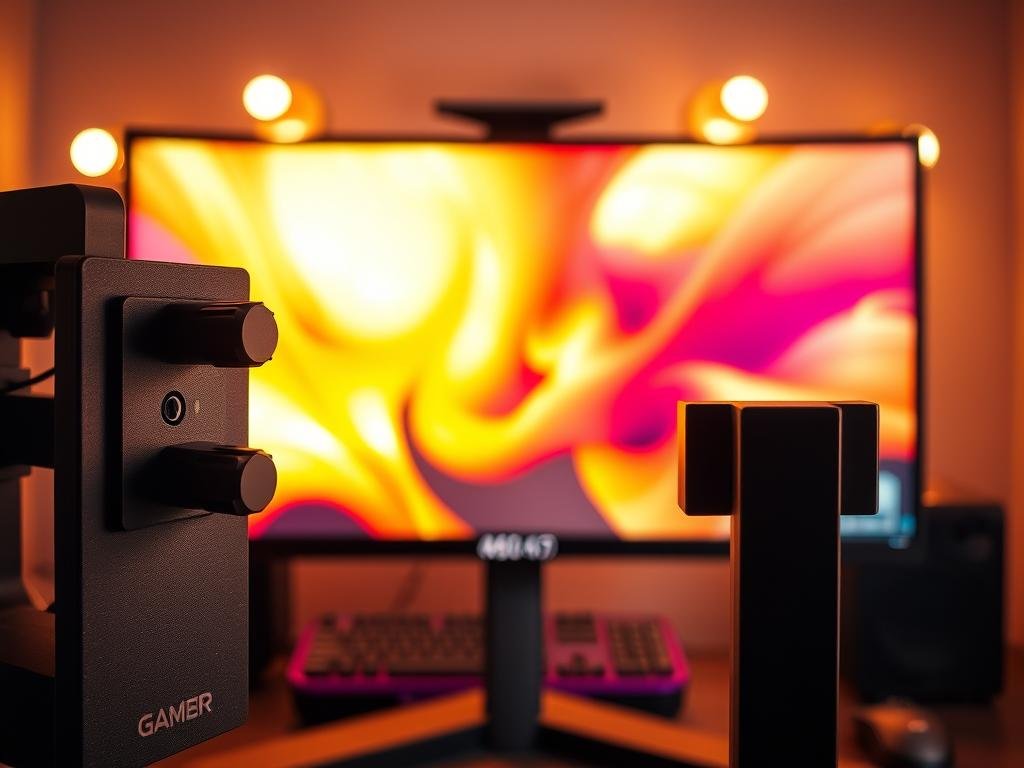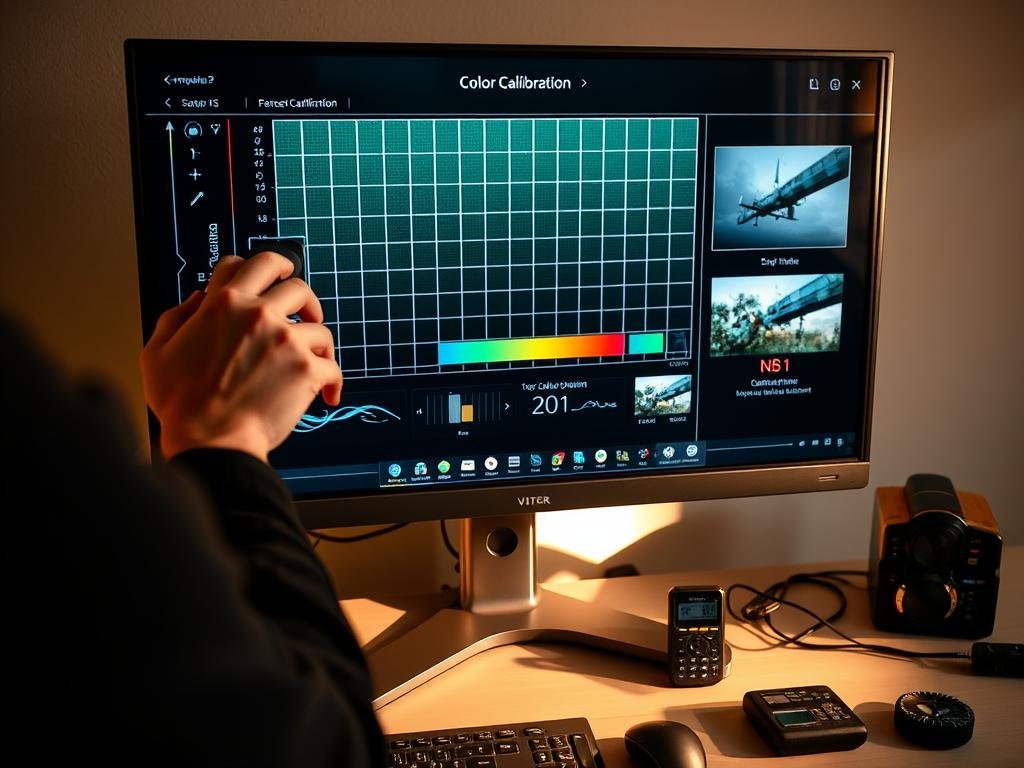“Details make perfection, and perfection is not a detail.” — Leonardo da Vinci
Quick guide: you’ll learn the simple process to tune your monitor for true-to-life color, contrast, and brightness. This improves image quality for games, video, and photo work.
Windows 11 and macOS both include built‑in tools to help. On Windows, open Control Panel > Color Management > Calibrate display. On macOS, go to System Settings > Displays > Color > Calibrate.
This flow adjusts gamma, brightness, contrast, and color balance. There’s also a separate HDR video path in Settings > System > Display > HDR > Display calibration for HDR video > Calibrate.
What you’ll gain: clearer targets in dark scenes, better HDR highlights, and consistent color across multiple screens. You don’t need extra hardware to see real improvement.
Why Calibrate Your Gaming Display for Accurate Color and Clarity
A well-tuned display reveals shadow detail and preserves bright highlights, improving what you see. Proper monitor calibration aligns what you view with real products and intended art direction. This gives you consistent color and better overall clarity across apps and platforms.
How calibration improves image quality, visibility, and immersion
Set a correct tonal curve so midtones look natural. Dark scenes reveal intended detail and bright areas stay controlled. That improves image quality and helps you spot elements hidden in shadows.
Balanced black levels and contrast boost visibility without washing out the screen. Proper settings also cut eye strain by preventing overly blue whites or overly dim scenes during long sessions.
Aligning on-screen colors with real-world accuracy for better results
Creators rely on accurate color to match printed or published outputs. When you tune white balance and color balance, skin tones and materials render as designed.
- You get reproducible results when you save profiles.
- Accurate colors make in-game cosmetics and UI hues match expectations.
- Proper contrast and brightness protect highlight detail in HDR cutscenes.
Prepare Your Monitor and System Before You Start
Set the scene for accurate results. Begin with the screen placed where you normally work. Stable placement and steady light help eyes adapt and keep your adjustments reliable.
Placement, lighting, and glare control
Put the monitor on a firm surface at your usual height and distance. Reduce reflections by closing blinds or moving lamps so no direct glare hits the panel.
Warm up and update drivers
Let the screen run for about 30 minutes. This stabilizes backlight and electronics so brightness and color settle.
Next, update graphics drivers from NVIDIA, AMD, or Intel to avoid conflicts during the process.
Return to native resolution and disable enhancements
Confirm native resolution and refresh rate in your OS to keep test patterns sharp.
Turn off dynamic contrast, super-sharpness, local dimming boosts, and noise reduction. Choose a neutral picture preset like sRGB or Custom.
- Reset custom GPU color tweaks so OS tools apply cleanly.
- Tidy cables and power to prevent intermittent signal issues with your computer and devices.
- When ready, follow built‑in directions for how to calibrate your display.
| Task | Why it matters | Target | Time |
|---|---|---|---|
| Placement | Reduces reflections and keeps viewing angle consistent | Eye level, correct distance | 5 min |
| Warm up | Stabilizes brightness and color | 30 minutes | 30 min |
| Driver update | Prevents color pipeline conflicts | Latest GPU drivers | 10–20 min |
| Disable enhancements | Removes processing that skews measurements | Neutral preset, off | 5 min |
Gaming Monitor Calibration with Built-In Tools
You can use native system wizards to fine-tune gamma, contrast, and color balance. The built‑in options in Windows and macOS walk you step‑by‑step so adjustments are predictable and repeatable.
Windows 11 path: open Control Panel, search Color Management, switch to the Advanced tab, and click the Calibrate display button to launch the wizard.

Follow the on‑screen instructions
The wizard asks you to adjust gamma first, then brightness and contrast, and finally the color balance for neutral grays. Use the provided instructions and on‑screen targets to align midtone dots and protect shadow detail.
HDR video and tone mapping
For HDR, go to Settings > System > Display > HDR and choose Display calibration for HDR video, then select Calibrate. This tailors tone mapping for HDR video and full‑screen apps.
macOS assistant
On macOS open Apple menu > System Settings > Displays > Color > Calibrate to run the assistant. The steps mirror Windows: gamma, brightness, contrast, and color balance, with clear options to save a profile.
- Keep a reference window visible while you tweak OSD values so changes match the examples.
- Repeat the steps to refine results and save the new profile when prompted so the system loads it at sign‑in.
- Document any OSD numbers (brightness, RGB gains) and check several colors and full‑screen video to confirm results.
Advanced Calibration: Devices, Software, and Profiles for Pro-Level Accuracy
For true accuracy, move from manual tweaks to measured profiling. Use a hardware colorimeter such as Datacolor Spyder or X‑Rite to measure color and luminance. Mount the device on your screen and let the software collect readings.
Pick the right software and generate an ICC profile
Run DisplayCAL, CalMAN, or Datacolor software to analyze primaries, gamma, and white point. The tool will build an ICC profile that the OS loads automatically.
- Set the monitor to native resolution and a neutral sRGB or custom preset before you start.
- Adjust RGB gains for white balance so the profile only makes small corrections.
- Tune brightness and contrast to a comfortable luminance (around 100–160 nits for SDR) while keeping near‑black and near‑white detail.
Validate and save repeatable results
Test with gradient images and real scenes to check banding, uniformity, and saturated color clipping. For gaming visuals, set black equalization conservatively to preserve shadow detail and confirm motion clarity without overdriving response time.
Save both new and old profiles and document your settings so you can repeat the process after firmware updates or panel aging. This gives consistent results across apps and devices.
Conclusion
Final check. Conclude by using simple test images and saved profiles to confirm tone, contrast, and brightness after any change.
Keep records, note OSD numbers and GPU settings so you can repeat the step quickly on the same computer or other monitors.
Re-run the monitor calibration process every few months, after driver updates, or when room light shifts. Use the Windows HDR video path if you handle HDR content.
Clean the screen, control ambient light, and store profiles per display. These small adjustments protect color accuracy and preserve long-term clarity for images and graphics.
With this guide, you have a repeatable process to maintain consistent, reliable results.
FAQ
How often should you calibrate your display?
You should recalibrate every 4–8 weeks if you work on color-critical tasks or notice shifts in color and contrast. For casual use, recalibrate every 3–6 months. Regular calibration keeps gamma, brightness, and color balance consistent as the panel ages.
Do I need a hardware device to get accurate results?
You don’t strictly need a colorimeter, but a device such as the Datacolor Spyder or X-Rite i1 yields far more precise and repeatable results than software alone. Software-only tools help basic settings, but a colorimeter plus DisplayCAL or CalMAN produces pro-level accuracy and an ICC profile you can trust.
Will calibration affect HDR content or high dynamic range video?
Yes. HDR requires separate adjustment steps because peak brightness and color volume differ from SDR. Use the built-in HDR video calibration on Windows or follow macOS HDR workflows to set tone mapping, peak luminance, and color gamut for consistent HDR playback.
What settings should you reset before starting the process?
Return to the native resolution, disable dynamic contrast/eco modes, and turn off sharpening or motion-enhancement features. Also set the display to its default picture mode and ensure your GPU drivers are updated to avoid software-side color management conflicts.
How do ambient light and placement affect results?
Ambient lighting changes perceived contrast and color balance. Calibrate in stable, moderate light and avoid direct glare. Place the screen upright on a stable surface and use neutral room lighting to prevent your eyes from biasing white point and brightness choices.
Can you create a consistent look across multiple displays?
Yes. Measure each screen with the same colorimeter and software, then create and apply ICC profiles for each device. Match white point (usually D65), gamma (2.2), and target luminance to achieve visual consistency across panels and systems.
Which software tools are best for fine-tuning color and gamma?
Professional options include DisplayCAL for open-source profiling, CalMAN for industry workflows, and Datacolor’s software bundled with Spyder devices. These tools let you adjust gamma, white point, contrast, and build ICC profiles for consistent color management.
Will calibrating improve game visibility and detail?
Yes. Proper adjustment of black levels, gamma, and contrast reveals shadow detail and improves perceived sharpness. Calibrated color balance also helps you distinguish subtle hues and improves target visibility in darker scenes.
Are the built-in OS calibration tools sufficient?
Built-in tools on Windows and macOS are useful for basic adjustments and quick fixes. They guide you through gamma, brightness, contrast, and color balance. For professional accuracy, pair them with a colorimeter and dedicated profiling software to create an ICC profile.
How do ICC profiles affect applications and games?
ICC profiles standardize colors across color-managed apps like photo editors and video software. Many games and some apps don’t use ICC profiles, so you may need in-game sliders for brightness and color. Still, a systemwide profile improves general color fidelity in supported programs.
